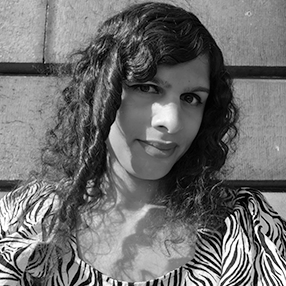
Out today from Nightboat Books, Nat Raha’s apparitions (nines) mixes lament with liberatory outcry. Raha’s poems live in the first-person plural, pushing against “authors who could not / conceive us,” a collective self-organizing and self-formalizing into “a threat to the tone & / image” of neoliberal politics. Dancing through the constraint of the niner form, apparitions plays with punctuation as a syllable, a visual cue, and an intercession against Anglophone lyric.
We discuss this new poetic form, Raha’s political and performance practice, and more in the conversation below.
—Morgan Levine
Morgan Levine: This book is a series of “niners,” poems with 9 lines and 9 beats or syllables in each line. This form was new to me, and it has a jaggedness, a disruptive quality that was so delightfully unnerving—in your note on the form at the beginning of the book, you call it a “sonnot.” How did you first learn about the niner, and what led you to pursue niners as a book-length project?
Nat Raha: The niner was coined by Mendoza (aka Linus Slug: Insect Librarian), a poet and researcher, who is a close friend. Their work is fascinated with dialect, found text, stories and frass found at the margins of history. The form was inaugurated in 2009, across nine chapbooks produced by Mendoza, each of nine poems, and a zine, FREAKLUNG, of nine poets writing niners (myself included). Mendoza described the form as a “sonnot”—and has discussed how its clipped forms of containment are more masochistic than, say, romantic. The niner’s constraints seem to pervert the strictures of classical anglophone verse (such as the iambic pentameter).
As I discuss in the afterword to apparitions, the book began as a response to the public assassination of a trans healthcare organization I was a part of, by right wing media (in 2017). I felt that the condensed form was suited to communicating political urgency—I imagined the first nine poems as communiqués, to be wheatpasted in the streets. I find the jaggedness useful as “cut” between poetic thought—the measure of the line holds swift syntactical shifts tightly. Especially across the first third of apparitions.
Morgan Levine: In addition to being a poet and scholar, you are also a political organizer. How do your poetics and political life mix? How do you see the relationship between poetry and protest?
Nat Raha: Poetry and political organizing offer contrasting and oftentimes coexisting approaches to social transformation. Poetry has limits in action, but also can provide and incite other dimensions towards transformative practices or praxis. I find that critical ideas may get borne and worked out in poems—they may later become the core concepts of an essay (for instance, the concept of “queer and trans social reproduction” that I develop in Transgender Marxism first popped up in a poem “(when we’re working while we’re asleep)”). Or, the poem can be a document for affective fervor, the event of a protest or a rally calling for political action, or of course of the desire for revolution itself. We can believe writing is everything, but it is never the only thing. Without an imaginary, movements become stale.
Morgan Levine: apparitions (nines) uses typographical symbols and punctuation marks throughout to divide words and lines, create beats and guide the reader to new meanings. Could you talk about your process in selecting particular symbols, and any hopes you might have for how a reader would approach them?
Nat Raha: The use of symbols and punctuation in this manner comes out of a drive to reinvent grammar—to feel and express queerness, transness, revolutionary fervor (or its failures). Inventing new punctuation—through selecting symbols, joining them together with a strikethrough or underline, has become a means to express noise, to articulate rage, to leave a trace of sonic and toxic overwhelm of urban environments. In apparitions, punctuation becomes syllabic within the nine-syllable line, intended to disrupt meaning, or to draw out phonemes; here, they often stand in for breath or its negation, as the poems contend with social or cultural vacuums (separability, racist policing, carcerality).
Morgan Levine: A key line for me in the collection comes on page 28: “writing / opaque / undoes our own straps—” Could you talk more about your relationship to sensemaking and intelligibility? Is there something liberatory—or erotic perhaps—about opacity?
Nat Raha: I often find myself pulled either in the direction of declarative political verse, or towards leaning into abstraction, each offering a different path to sensemaking (in the most expansive understanding of what that entails). However, the demand of neoliberal multiculturalism on marginalized folks—especially of black and brown people, but also including queer and trans liberalisms—is to explain ourselves. Meanwhile, erotic sense operates often on a non-verbal, embodied or embodiminded level. I think writing can respond to the creativity found, say, in erotic touch. And in addition, working through abstraction can emphasize other elements, such as the sonic resonances and music of the words themselves—shifting towards something more affective, or ASMR, than legible. It activates sensation. Plus, the lines you cite are also invoking a scene of lesbionic poetics, soundtracked by the Cocteau Twins.
Morgan Levine: It was inspiring to hear these poems live at Word Is Change! How did you develop your performance practice?
Nat Raha: I’ve been doing readings for 15 years, often searching for means to build layers, or remix the work live—plus working with embodied presence. apparitions has its own condensed urgency—of survival, resistance, and finding means to life otherwise as an imperative, so I want to hold that in its rage, clarity and tenderness. That these demands and practices of decolonial justice held in the poems come back to one’s ensouled bodymind. That our presences here are a testament to resistance, and for that to be sounded and articulated in performance.
